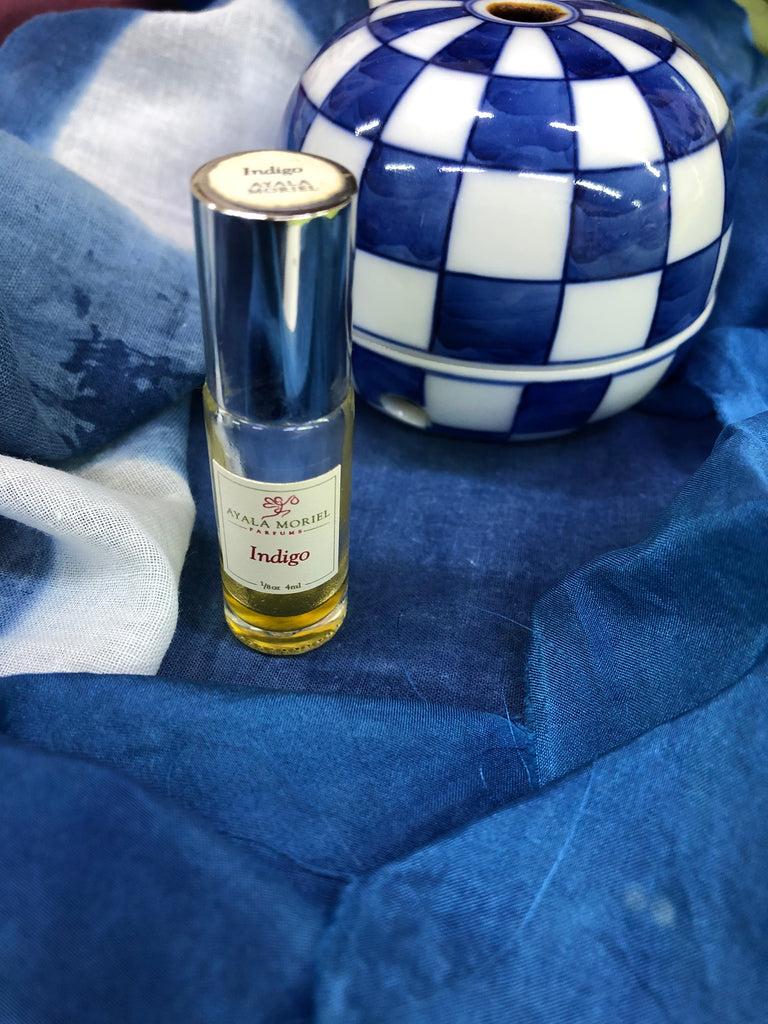Indigo: Natural Perfume & Botanical Dye
Indigo. A mysterious blue substance with unknown origins, looks like a mineral - a dark blue rock - but in fact it comes from plants (usually). It behaves like magic, creating multiple shades of blue, deep purples and even green-grass and turquoise. Preparing an indigo vat is like a magical ritual, involving vigorous stirring and observing strict guidelines, while summoning invisible forces in the air, water and earth to come together and help break down this stubborn substance, making it a clear yellow-green, and giving birth to the elusive Indigo Flower - a bubbly froth . Dipping cloth or yarn in it is even more ceremonial, requiring careful handling when dipping into the vat, removing from it, rinsing in water, exposing to air... Like I said, all the elements are at work here! And most impressive of all, the cloth comes out looking yellow-green, and quickly turns into turquoise before it transforms completely into blue (see photo below of a bundle of wild-lettuce shibori coming out of the vat and changing colours).

Technically speaking, Indigo is the most stable, durable, lightfast and wash fast colour on the planted. Every continent has its own indigo-containing botanicals, for example Indigofera tinctoria (from the Fabaceae family) from India, Polygonum tinctorium (Dyer's Knotweed, from the buckwheat family) from China and Japan, and Isatis tinctoria (woad) in Europe, which is rather weak due to lower levels of indigotin. Also, some animals (mollusk that was used to produce both the esteemed techelet (sky blue) and argaman, (royal purple), that was used religiously for dyeing ceremonial clothing articles the Jewish temple and garb.
Indigo is the dye used for Shibori (Japanese resist dying, AKA tie dye), and also the colour used for most fabrics in Boro quilting are coloured with). The thread for Sashiko is often dyed with indigo as well (although if the fabrics stitched on are blue it will likely will be a white stitch). Indigo is what the Imazighen and Tuareg (the indigenous people of North Africa) garb is dyed. And that's how denim (jeans) are dyed, although now it's mostly synthetic indigo that is used for that (and has a very harmful impact on the environment).
For those of you living in Israel and intrigued by indigo dyeing, get in touch with Hagar Zachar, who teaches indigo workshops in her farm in Alon HaGalil, with the philosophy of farm-to-dyepot and sustainability in mind. She also makes her own floral water-colours, teaches indigo dyeing techniques, indigo vat building & maintenance, and how to extract indigo from the leaves. For any floral heads and natural dye amateurs, meeting with her is highly recommended!
One of the things I enjoy the most about Indigo dyeing is the scent of the organic indigo vat. Whether based in henna, bananas or dates or any other source of starch or sugar, organic vats (as opposed to mineral vats, such as those based in iron or ammonia) are very fragrant, bringing to mind the scent of milky bubble tea. It's such a soothing and addictive scent, and I resist sipping it by reminding myself of all the lime (calx) that's in the vat, which makes it way to alkaline for ingestion!

Indigo perfume was created long before I had any notion of the process of indigo dyeing, or its smell. It is more of a translation of that mysterious colour, the deep dark blue, similar to that "blue hour" referenced in Guerlain's famous perfume. The inspiration for this was my mother, and her velvety hug, soothing and soft. Before leaving for Canada, she gave me one of her blouses, a blue velvet hoody that helped me remember that hug and feel close to her even beyond many continents and oceans. That particular fabric is cool to the touch but very soft and also reminds me of my mother's personality, forever flickering between warmth and coolness.
Indigo perfume contains many unusual notes: boronia, violet, caraway, carnation and aniseed over a cool-warm backdrop of Himalayan cedar, frankincense and a proprietary amber base. Somehow that combination together creates a scent that reminds me a lot of vitex, which although not directly associated with indigo dyeing, is a wonderful ecorpinting plant, giving a beautiful shade of green and very clear shapes of either leaves, branches, flowers or berries. When layers over indigo, the colour it gives is a beautiful turquoise, as you can see in the picture below.





